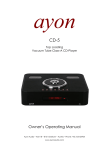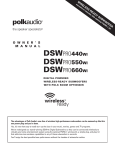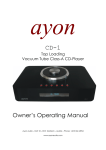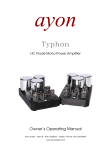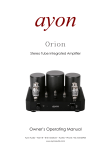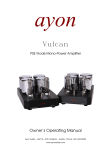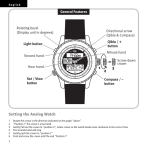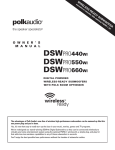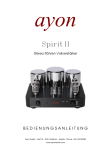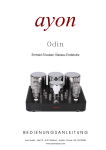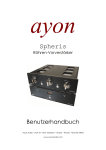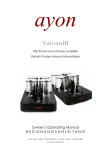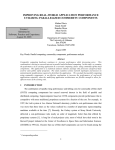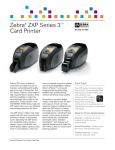Download Condor - Ayon Audio
Transcript
ayon Condor Loudspeaker Owner’s Manual Ayon Audio – Hart 18 – 8101 Gratkorn – Austria – Phone: +43 3124 24954 www.ayonaudio.com INTRODUCTION Thank you for choosing Ayon loudspeakers. Your speakers feature unique and highly advanced technologies in a profoundly realistic and moving musical experience. The care in engineering and manufacturing of this product anticipates a lifetime of enjoyment. Please take time to read carefully the installation section of this manual before using your heron loudspeakers. We also encourage you to enlist the aid of the dealer from whom you purchased this Ayon loudspeaker. Your dealer is an excellent source of information on compatibility, installation, and troubleshooting, and should be capable of helping ensure that your overall music system provides you with maximum performance and satisfaction. HANDLING TIPS IMPORTANT: Use only a soft furniture polish appliance. Do not use cleaners that contain ammonia, strong solvents, or abrasive materials. Use of these materials can degrade, scratch, or even destroy the finish. WARNING: Do not apply polish to the loudspeaker drivers. The drivers (woofer, midrange, and tweeter) require no regular maintenance. Do not attempt to clean the midrange or tweeter dome, as they are easily damaged .If desired, you may remove dust from the woofer cone by using a small, soft dusting brush. Notice: The front grilles are fragile and can be easily damaged. Do not over – tighten the spikes or any screws. Serial Number: Dealer: Tested by: -1- TABLE OF CONTENTS 1. 2. 3. 4. 5. 6. 7. 8. Unpacking Connections Break in period Toe in Room acoustics Room placement guideline Specifications Warranty and service UNPACKING Ayon Condor loudspeakers are delivered in cartons and feature a cover which also serves as dust and scratch protection in times when the speakers are not in use for longer periods. a) Place transport cartons on even, solid surface and open the bottom cover. b) Remove speakers from their cartons. This will necessitate two persons to do. Place them on a soft surface (carpet). Do not insert the spikes until you have determined the final position of the speakers in your room. c) Move speakers to their preliminary position in your listening room; avoid the bottom plate to get in contact with rough surfaces. CONNECTIONS The very high current input terminals (WBT) located on the rear of your Condor loudspeaker are colour coded so that RED corresponds to positive (+) and White (-) to negative, or common, or ground on the amplifier output, be sure of the very highest quality loudspeaker interface cables. The damping factor of an amplifier is a function of the amplifiers output impedance into a given load impedance solid state amplifiers, due to their intrinsically low output impedance, tend to have a higher damping factor than vacuum tube amplifiers vacuum tube amplifiers typically are transformer-coupled in their output stage and the secondary windings of the output transformer present a relatively high source impedance. Connect the positive (+) output (amp) to the red input connector on the Condor. If use a vacuum tube amp, the positive (+) output is usually marked with the impedance value like 4 ohm, 8 ohm or 16 ohm. Notice: We recommend strongly for the Heron to use 8 ohm connection ( + ) on your tube power amplifier! -2- BREAK IN PERIOD Your new Ayon Condor loudspeakers have an initial break – in period. They will not perform to their full sonic potential when first installed in your system. This is partially due to a residual polarization of the dielectric materials used in the crossover capacitors and internal wiring. As music is played through the loudspeakers, the electrical signal will gradually anneal these materials. Similarly, the suspensions of the drivers will reach their optimal mechanical properties as the speakers are played. Only after the break- in period will the full performance of your Ayon loudspeakers is realized. The break-in process will occur naturally as music is played through the system. To reduce the time required, it is recommended that the system be played continuously, using either a digital source in the repeat made or an FM broadcast signal. The recommended break-in procedure is a follows: ° Initial warm-up: three to six hours of quit music. ° Extended break- in: 100 to 200 hours of loud and dynamic source material. During the break-in period, the sonic properties of your loudspeakers may undergo several gradual shifts as the various components break –in at different rates. It is therefore suggested that the fine tuning of the system be delayed until after the break – in period is completed. However, during the final phases of the break –in period, the sonic image will open up, the sound stage wills again specificity, the bass control and impact will increase, and the overall sound will have a more, involving presentation. TOE IN Adjusting the toe in angle of the speakers is useful in tailoring the sound to best match the characteristics of your system and listening room. When the speakers are facing straight forward, they tend to create a large, expansive sound –stage, painted with broad brush strokes. As they are rotated toward the listening position, the image becomes more compact, with increased focus, creating a greater sense of intimacy. Pointing the speakers inward is also helpful in situations where strong reflections from the side walls are a problem. Start with the loudspeakers facing straight forward, and play either a mono source, or a stereo source with a distinct center image through both channels. Carefully rotate the loudspeakers inward in small increments to bring the image in precise center focus. Toe- in adjustment is rather delicate, and experimentation is necessary to achieve the proper angle for your listening situation. The optimum angle is usually between 3° and 10° (degrees) inward. -3- ROOM ACOUSTICS REFLECTIONS Probably the most obnoxious form of reflection is called “slap echo” in slap echo, primarily mid-range and high frequency sounds reflect off two parallel hard surfaces the sound literally reverberates back and forth until it is finally dissipated over time. You can test for slap echo in any room by clapping your hands sharply in the middle of the room and listening for the characteristic sound of the echo in the mid-range. Slap echo destroys the sound quality of a stereo system primarily in two ways by adding harshness to the upper midrange and treble through energy time storage and by destroying the delicate phase relationships which help to establish an accurate sound stage. Non parallel walls do not support slap echo, but rather allow the sound to diffuse. REFLECTIVE ACOUSTICAL COMB FILTER EFFECT Acoustical comb filtering occurs when sound from a single source, such as a loudspeaker, is directed toward a microphone or listener at a distance .The first sound to reach the microphone will be direct sound, followed by delayed reflected sound. Because the reflected sound lags in phase relative to the direct sound, there will be cancellation at certain frequencies where the two are 180 degrees out of phase, and augmentation at other frequencies where the direct and the reflected sounds arrive in phase. Because it is a function of wave length, the comb filter effect will notch out portions of the audio spectrum at regular octave-spaced intervals. The subjective effect of comb filter effects is an added roughness to the sound, a reduction of harmonic richness and a smearing of lateral sound stage image focus and placement the side wall reflections. RESONANCES Resonances in listening rooms are generally caused by two sources: 1. The structures within the listening room 2. The volume of the air itself in the listening room. Structural resonances are familiar to most people as buzzes and rattles, but this type of resonance usually only occurs at extremely high volume levels, and is usually masked by the music. In many wood frame rooms, the most common type of structural resonance problem is “booming” of walls and floors. You can test for these very easily by tapping the wall with the heel of your hand or stomping on the floor. If it a wooden floor, this is done to detect the primary spectral center of the resonance. -4- To give you an idea of what the perfect wall would sound like, imagine rapping your hand against the side of a mountain. Structural wall resonance generally occurs in the low to mid- bass frequencies and adds tonal balance fullness to any played in that room. The too are more prominent at louder levels, but their contribution to the sound of the speaker is more progressive. Rattling windows, picture frames, lamp shades, etc. can generally be silenced with small pieces of caulk or with blocks of felt. Short of actually adding additional layers of sheet rock to flimsy walls, however, there is a little that can be done to eliminate wall resonances. The volume of air in a given room will also resonate at a frequency determined by the size of the room. Larger rooms will resonate at a lower frequency than will smaller rooms. Air volume resonances, and low frequency standing waves, together combine to form low frequency coloration in the sound. At its worst, it is a grossly exaggerated fullness which tends to obscure detail and distort the natural tonal balance of the speaker system. Occasionally, however, there is just enough resonance to give a little added warmth to the sound. Tube traps have been found to be effective in reducing some of this low frequency room coloration. Custom designed and constructed bass traps, such as perforated Helmholtz resonators, provide the greatest degree of low frequency control. SHAPE OF THE ROOM A perfectly square room is probably the worst room shape for most loudspeaker applications. In a square room, standing wave production is most efficient, and hence objectionable. Long narrow, rectangular rooms also pose their own special problems, creating several standing wave modes along their length. Slap echoes along axis of the room can be particularly disturbing to sound staging because of the relatively long time delay between echo intervals. These long rooms are often quite lean in the bass near the center of the room (where most listeners would prefer to sit). This midroom bass leanness is made worse if there are large windows on the narrows walls. Although maximum low frequency response would probably be achieved by placing the loudspeakers along the narrow wall of the rectangular room. Optimal stereo imaging and midrange clarity would be achieved by placing the loudspeakers along the wall, L- shaped rooms would seem to present the same dilemmas as a long, rectangular room, however, the asymmetry of the acoustical space tends to break up standing waves and can provide a better listening environment. -5- ROOM PLACEMENT GUIDELINE Recommended Procedure 1. Begin by dividing the room from left to right by an odd number such as 5, 7, 9 or larger. You will then have a dimension that is one-fifth, oneseventh, or one-ninth the room width. Ideally, you will be able to place the loudspeaker on one of these left to right divisions; for instance twosevenths from the left side wall and two-sevenths from the right side wall. Using this guideline assures the best room cancellation between left and right and provides for the best stereo separation and imaging. 2. The distance from the back wall affects the bass performance too. A good starting point would be with the loudspeaker center 20-25 inches from the back wall, with the speakers about 6 to 8 feet apart center to center. 3. Face the loudspeaker straight forward, unless corner placement is utilized. 4. It is a good practice to have curtains or other acoustically absorbent material on the walls or other direct reflecting surfaces behind and/or between the loudspeakers. If there is a sidewall to the outside of the loudspeaker that is closer to the loudspeaker than to the listening position, it is highly advisable to treat that wall to minimize acoustic reflections. Place a stand-up mirror (or have someone hold a smaller mirror) against the sidewalls and sit in the listener's positions. The position where you can see the driver's reflection is the direct reflective position and is the best position to apply anti-reflective material. Another option, preferred by many is to fire the loudspeaker across the short axis of the room, which will mitigate early side reflections. 5. Listen to the vocal disc or another of your favourite test disks where mono voice only is presented. At this time, only listen for natural voice tonality. Move the speakers forward 1.5" at a time if the voice sounds thick with a boxy nasal coloration on the lower octaves. Move the speaker backward if the voice has tremendous upper register megaphone presence and snap. Do not worry about toe-in at this time; point the loudspeaker straight forward. 6. Listen to some music, make sure that the upper bass snare drums have good attack and that the lower bass is well defined and full bodied. In fine-tuning, we notice a kind of seesaw effect. When the upper bass goes louder, the lower bass goes down and vice versa. If the upper bass does not have good attack, you will have to position the loudspeaker forward slightly. If the lower registers are not loud enough in comparison to the upper bass registers, you will have to move the horns backward slightly. Listen to the voices. -6- 7. If the voices sound smothered sat on or dead and the lower bass is fat, you will need to move the loudspeaker forward by about 0.5" to 0.75". If the voices sound thin with more focus in the higher registers you will need to move the speakers backward by about 0.5" to 0.75 ". Repeat until the desired effect is achieved. 8. Listen to the Immersions in the middle position. Move over to the left position in line with the left driver. Do the same at the right driver position. Make sure that the tonal balance is essentially the same in all positions. Specifically listen for brightness in the upper midrange in all positions. If the room is a hard or bright room (with many high frequency reflection problems) a slight toe in may work best. An even tonal balance is important. If you have to toe in slightly it will be good to aim at a position between the centre listener and outer listeners. Doing the odd number divisions on the back wall and aiming for those positions can be beneficial. 9. Now, listen to the Immersions for any obvious anomalies in the music. These usually show up as screaming upper midrange on saxophone, trumpet and some loud female vocals. If there is a tendency to sound peaky or sharp in the upper midrange, you can either: 1) move the loudspeaker back slightly (first option); or 2) slightly closer to the sidewalls (second option). Or 3) if the loudspeakers are at toe in at this time, you may elect to toe them out slightly (third option). Listen to the speakers in the new position to determine if the problem is now resolved. If you are happy with the results, you can repeat this test at a higher listening level, for further fine-tuning and refinement of the music presentation. The higher the power of the amplifier, the more likely the need for these adjustments will be. 10. Now listen for a nice even spread of the sound from left to right with no hole or mono bulge in the middle. Move the loudspeakers closer together to close the hole and further apart to flatten the mono bulge. Some Test & Burn-In CD tract with out of phase voice are very good for this setup. 11. Now may be a good time to lower the spikes using. (On wooden or tile floors, protection is recommended between the spike and the floor to prevent marring of the floor; a coin can be used for this purpose.) The audible results of the addition of the spikes, is to increase the dynamic impact of the music, provide better focus, and to tighten the bass. If the insertion of the spikes results in a slightly cooler sound than you prefer, the slide-in choke may be moved in slightly, or move the speakers back very slightly in the room (0.25"). Either of these adjustments will return warmth to the music. Place seats so that the listener's ears will be the same distance from the listener's back wall as the distance of the speaker wall to the center of the loudspeaker. -7- 12. Listen at this position and move the listener position slightly back to make sure that the bass does not get too overwhelming. Also, make sure that you do not get any high frequency bounce from the back wall. Some back wall treatments maybe needed. 13. Now, you can start working on increasing the layering of the music and the depth of field of the soundstage. Very small incremental adjustments in placement and angle changes are the key here. Any change in interconnects, speaker cable, and/or other favourite tweaks will affect the tonal balance. Repeat the steps above as needed to restore control of the coupling between the speaker and the room again. SPECIFICATIONS Speaker System - IPRCS Ayon Condor 3-way Inverted parabolic resonance correction system Cabinet Resonance optimized Driver Complement Impedance Sensitivity (1W / 1m) Recommended Amp Power Frequency Response Single-Wire Terminal Crossover design - CMFIC Internal Wire Recommended connection (+) for tube amps (4, 8, 16 Ohm) Dimensions (HxWxD) each Weight, each Shipping Dimensions (HxWxD) each Shipping Weight, each ayon® 1” Revelator - Ring Radiator 6” ATC Midrange 2 x 9” Eton Nomex-Kevlar Woofer 6 Ohm 91 dB 20 – 250 Watt 30 Hz – 45 kHz / -3 dB WBT Crossover magnetic field interaction control Harmonically signal flow distance wiring 8 Ohm 130x31x54 cm 70 kg 140x41x64 cm 85 kg is a registered trademark Ayon Audio – Hart 18 – 8101 Gratkorn – Austria – Phone: +43 3124 24954 www.ayonaudio.com -8- WARRANTY AND SERVICE LIMITED WARRANTY Ayon Audio speakers are warranted by the manufacturer to be free of defects in materials production for a period starting 3 years from the date of purchase. Under this warranty defects are repaired free of charge. The purchaser is responsible for transportation from his location to the original sales agent, national distributor, or international distributor, whoever is closest. This warranty applies to the original purchaser only, and it is non-transferable to subsequent purchasers within the original 3 year period. Contact your dealer or Ayon Audio for commercial warranty policies. Request for repair under this warranty need to be accompanied by an unaltered copy of the original purchase receipt. IN THE EVENT OF A PROBLEM In the unlikely event of a problem with Ayon loudspeakers, the component most susceptible to failure is one of the driver units. If driver replacement is required, have your dealer contact Ayon. The performance curves of the drivers in each pair of loudspeakers are kept on file at the factory. This enables Ayon to supply an exact replacement unit. Ensuring continued operation at the highest level of performance. The defective driver must then be returned to the factory for inspection to determine the status of the warranty claim. This on-site replacement of the driver units eliminates the time and expense of shipping the entire speaker to the factory for repair. All warranty claims must be made through an authorized Ayon dealer or distributor. CONDITIONS This warranty is subject to the following conditions and limitations. The warranty is void and inapplicable if the product has been used or handled other than in accordance with the instructions in the owner`s manual, abused or misused, the drivers have been damaged due to amplifier defects, electric shorts or use of excessive power, the serial identification plate and serial number has been removed from the speaker, damaged by accident or neglect or in being transported or the defect is due to the product being repaired or tampered with by anyone other than Ayon Audio, or an authorized party. Ayon reserves the right to modify the design of any product without obligation to purchasers of previously manufactured products and to change the price or specifications of any product without notice or obligation to any person. ayon® is a registered trademark Ayon Audio – Hart 18 – 8101 Gratkorn – Austria – Phone: +43 3124 24954 www.ayonaudio.com -9-










